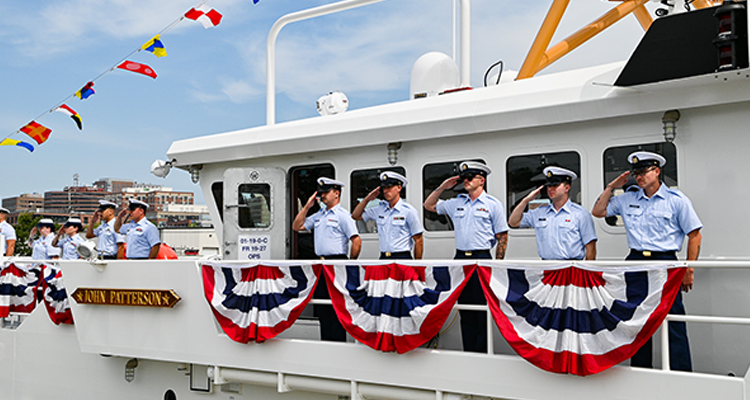
Crewmembers of Coast Guard Cutter John Patterson render a salute as the cutter is placed into commission during a ceremony in Portland, Maine, Aug. 10, 2023. The cutter is the 53rd fast response cutter (FRC) in the Coast Guard fleet and will be the fourth FRC to be stationed in Boston. U.S. Coast Guard photo by Petty Officer 2nd Class Diolanda Caballero.
Commissioning of the Coast Guard’s newest fast response cutter (FRC) took place Aug. 10, 2023, in Portland, Maine. Coast Guard Cutter John Patterson is the fourth of six FRCs to be stationed in Boston, and the 53rd FRC to be commissioned.
The cutter was named for Gold Lifesaving Medal recipient John C. Patterson, who served in the U.S. Life-Saving Service for 16 years. Patterson was born in 1834 to a local farm couple in Howell, New Jersey.
After serving in the Civil War with New Jersey’s 14th Militia Regiment, Patterson signed on with the Life-Saving Service, entering as a surfman in 1870 at Station Sandy Hook, New Jersey. He was appointed the keeper at Sandy Hook in 1876 and remained there until his transfer to Station Shark River, New Jersey, where he served as keeper from 1883 until his retirement three years later.
In July 1885, Patterson and his crew of surfmen responded to a distressed vessel, the yacht Foam, caught in a heavy onshore gale and taking on water off the coast near Avon, New Jersey.
Though Station Shark River had not yet begun seasonal operations, Patterson marshalled his men from the nearby towns of Ocean Grove and Asbury Park, borrowing a team of horses to pull the cart loaded with rescue gear to a point adjacent to the sinking yacht.
After four unsuccessful attempts to fire a shotline to the yacht to rig the breeches buoy, Patterson made the call to launch the station surfboat from shore. However, heavy winds and severe currents prevented the crew from reaching the yacht, so they returned to shore to wait for an opening in the storm. Patterson and his men were finally able to use a break in the weather to get close enough to the Foam so the stranded crewmembers could leap into the water and be pulled safely into the surfboat.
After an hour of rowing through heavy seas and breaking surf, the rescue craft made landfall with all survivors safely aboard. By that time, a crowd of over 4,000 people had gathered to watch the heroic rescue. Patterson’s choice to put duty above all else earned him the Gold Lifesaving Medal; his crew members and one additional volunteer were awarded Silver Lifesaving Medals.
The Sentinel-class FRCs feature advanced command, control, communications, computers, intelligence, surveillance and reconnaissance equipment; over-the-horizon cutter boat deployment to reach vessels of interest; and improved habitability and seakeeping. The cutters are designed for multiple missions including search and rescue; national defense; ports, waterways and coastal security; drug and migrant interdiction; and fisheries patrols.
The Coast Guard has ordered 65 FRCs to date. With this commissioning, 53 are in service: 13 in Florida; seven in Puerto Rico; six in Bahrain; four each in California and Massachusetts; three each in Alaska, Guam, Hawaii, Texas and New Jersey; and two each in Mississippi and North Carolina. Future FRC homeports include Astoria, Oregon, and Kodiak and Seward, Alaska.
For more information: Fast Response Cutter Program page